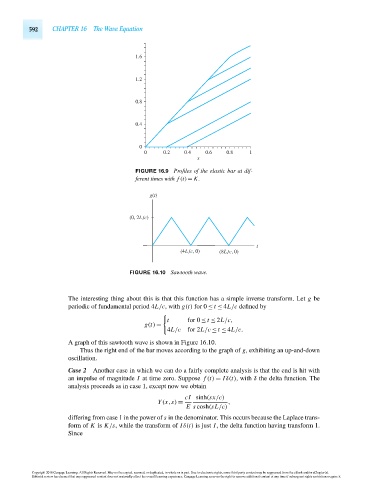Page 612 - Advanced_Engineering_Mathematics o'neil
P. 612
592 CHAPTER 16 The Wave Equation
1.6
1.2
0.8
0.4
0
0 0.2 0.4 0.6 0.8 1
x
FIGURE 16.9 Profiles of the elastic bar at dif-
ferent times with f (t) = K.
g(t)
(0, 2L/c)
t
(4L /c, 0) (8L /c, 0)
FIGURE 16.10 Sawtooth wave.
The interesting thing about this is that this function has a simple inverse transform. Let g be
periodic of fundamental period 4L/c, with g(t) for 0 ≤ t ≤ 4L/c defined by
t for 0 ≤ t ≤ 2L/c,
g(t) =
4L/c for 2L/c ≤ t ≤ 4L/c.
A graph of this sawtooth wave is shown in Figure 16.10.
Thus the right end of the bar moves according to the graph of g, exhibiting an up-and-down
oscillation.
Case 2 Another case in which we can do a fairly complete analysis is that the end is hit with
an impulse of magnitude I at time zero. Suppose f (t) = Iδ(t), with δ the delta function. The
analysis proceeds as in case 1, except now we obtain
cI sinh(sx/c)
Y(x,s) = ,
E s cosh(sL/c)
differing from case 1 in the power of s in the denominator. This occurs because the Laplace trans-
form of K is K/s, while the transform of Iδ(t) is just I, the delta function having transform 1.
Since
Copyright 2010 Cengage Learning. All Rights Reserved. May not be copied, scanned, or duplicated, in whole or in part. Due to electronic rights, some third party content may be suppressed from the eBook and/or eChapter(s).
Editorial review has deemed that any suppressed content does not materially affect the overall learning experience. Cengage Learning reserves the right to remove additional content at any time if subsequent rights restrictions require it.
October 14, 2010 15:23 THM/NEIL Page-592 27410_16_ch16_p563-610

